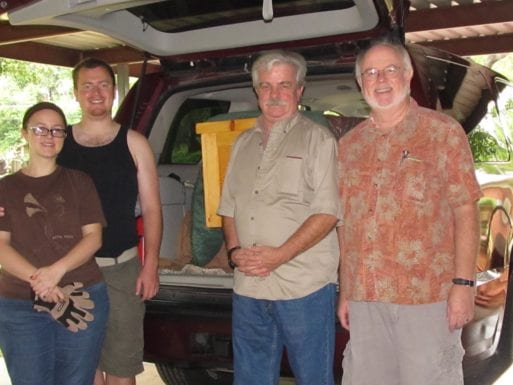
Jim Bates, right, poses with family members after loading his father’s body for transport.
Six years ago, Jim Bates and his brother drove their father’s body 355 miles from Arlington, Texas, to Tulia, Texas, where he was from, to bury him alongside his wife. As director of the Funeral Consumers Alliance of North Texas, Bates has since coached about six people doing body transports — to Houston, Mexico and elsewhere. He’s also advised around 20 people on best practices to obtain their loved one’s body from a hospital or nursing home without involving a funeral director.
When Bates picked out the pine box for his father, he also got one for himself, rubbing it down with five coats of tung oil and placing it in storage. Bates, who’s passionate about the meaningful nature of DIY body transport and funeral rites, is planning to be buried 550 miles away on the northern border of Big Bend National Park, in a cemetery on his friend’s 40-acre plot of land. He expects his son-in-law will take him there. “I said, ‘Hey dude, it’s going to you,’” Bates said. “He likes the great outdoors, and he’s got a four-wheel-drive pickup truck because the road is really tough to get out there. So he understands he’ll be the guy with the Buc-ee’s napkins and duct tape and plywood and chainsaws, or whatever it takes to get it done.”
For those who’d like to learn what, exactly, it does take — and the unexpected benefits of DIY body transport — Bates has shared his experience and insight. For further questions, he can be reached through FCANT’s website.
This interview has been edited for length and clarity.
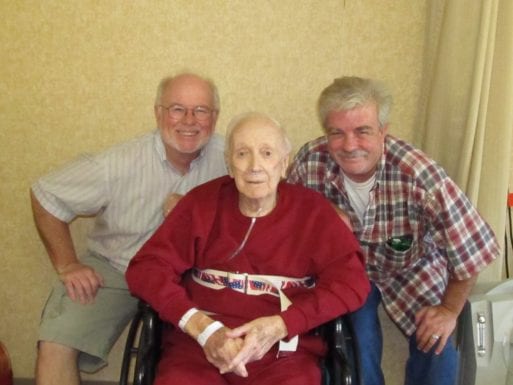
Bates with his father and brother toward the end of his father’s life.
When might a family choose to transport a loved one’s body themselves?
They just want to. Transporting a body can be expensive. A 300-mile transport, which would be a typical Texas run inside the state, is about $1,500. You’re paying for someone to get out there with the box in the back. But then you’re paying for them to come back empty.
Is it possible for a person to do it themselves?
Oh yeah. In Texas, it’s routine for family members from where I’m at in Fort Worth to transport bodies down to Mexico — it’s about 350 or 400 miles to the border. It’s probably not so routine to transport a body to Oklahoma or Nebraska or elsewhere in the U.S. People think it’s against the law, so they just don’t do it. It’s a huge misconception.
What kind of vehicle should someone use — can they just rent a van?
It’s just hauling freight. You just measure whatever container you’ve got and measure the van or pickup to see if it’ll fit. With most any minivan, they’ll pull out the seats — the middle and the last row. That’s how most bodies are transported by funeral homes. And because the box lays low on the floor, you can’t see it through the windows. A Chevrolet Tahoe will fit if you just fold down both rows of seats — that’s what we did with my dad. Pickup trucks are easy to load, typically long enough, but the body’s out in the sunshine and the rain. But a good, heavy tarp, and it’s all right.
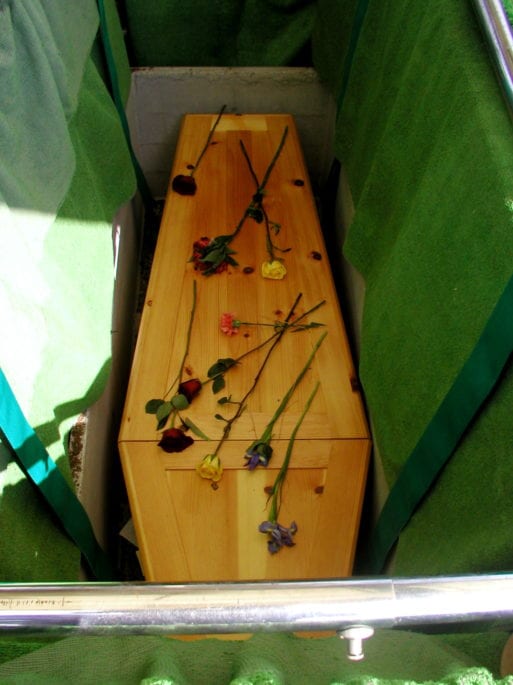
Bates’ father was transported in a pine box, with dry ice under the small of his back.
If a family wants to take their loved one’s body from a hospital or care home, what do they need to know?
Most hospitals, nursing homes and other systems have a policy that when their customer dies, the family has to call a funeral home to pick up the body. When a family refuses, there’s immediate push-back.
That policy is actually against the law. First, they’re forcing the family into a contract with a funeral home. So it’s a contract under duress, which is illegal anywhere in this country. And then the second issue is that it’s the family’s responsibility to dispose of the body how they see fit, so the corporate policy goes against that. Lawyers understand when it’s stated to them that way, and will tell the hospital, “Let them have the body,” because they don’t want any trouble. When I’ve coached people, we’ve never lost that fight.
In Texas — I don’t know about other states — it’s illegal to hold a dead body hostage for any reason. So if a funeral home has the body and the family goes down there and they don’t have any money to pay for anything, the funeral home can’t say, “We’re just going to keep old dead Fred here until you come up with the money and it’s going to cost you a hundred dollars a day for refrigeration.” That’s holding a body hostage.
If the family’s going to pick up the body, how many people should they bring? Do they need any special equipment?
It’s not the hospital’s job to have a body board or anything like that, because they’re accustomed to the funeral home coming in with the equipment. The body will come out on a gurney in a slip sheet. I don’t know how many dead bodies you’ve handled, but they’re pretty difficult. So the family just needs a body board — they could get a body bag, which is still not rigid, but a lot of them have handles. You just need something to slip under there and have some handles on it, pick it up and put it in the minivan. Plywood’s really expensive nowadays, but maybe an ironing board or whatever works. And four people for 100 pounds would be about right.
Are there any laws that regulate how the body can be transported, especially if you’re crossing state lines?
They’re out there. They’re very weak in a good way. I don’t know all the state laws, though there’s a book called Final Rights: Reclaiming the American Way of Death, by Lisa Carlson and Joshua Slocum, that breaks that down. But what it gets down to in Texas is that you have to have a burial transit permit, and that’s used by many different states depending on their statutes. Say you get pulled over in Kentucky by the highway patrol for speeding, and they look in there and you’ve got a dead body. You pull out your little old burial transit permit and show it to them.
In Texas, the funeral industry makes it sound like it’s a huge thing. And it even says on the permit to take it to the registrar and all this bureaucratic stuff. But there’s also enough leniency on the permit itself. I’ve done this three times, and we have a copy on our website. You just print it, you fill it out yourself. You don’t notarize it. You don’t take it to the registrar because it says on there that the funeral director or person acting as such can fill it out on their own and mail or fax it promptly. So just get the permit or whatever’s necessary in the state you’re in, find out what that is.
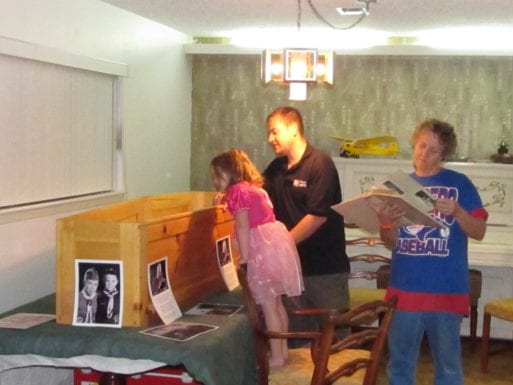
Bates’ family memorializes his father in his home after death.
If somebody wants to find out the laws in their state, where’s the best place to look? Should they call a local funeral director?
That’s going to complicate things. Most of the time the funeral directors think that whatever they’re required to do, laypeople are required to do the same thing. And they’re not — there’s really hardly anything, almost nothing in Texas law, that applies to the family. The only thing is the cremation temperature. If you want to do it yourself on top of a bunch of mesquite logs, it’s got to be 1400 degrees for two and a half hours. And then the law on burial is roughly two feet down and more than 150 feet from a continuous stream or running water source. So pretty much in 30 seconds, I can cite the laws that apply to families.
The statutes can be pretty tough to find — especially on transportation. A lot is in the funeral regulatory statutes, but they can be a bit scattered — hauling across state lines could be under public health law. And then if you call the regulatory people, that’s not necessarily going to work either. Either they aren’t very helpful, or they just adhere very closely to the industry.
I’d say, do a good faith look at the statutes, search a bunch of terms on the state website and have a little folder documenting what you’ve found. And then just rock on and do what you want to do. If somebody challenges you, you can say, “I’ve tried really hard to find this.” I mean, who is the expert in the industry? Who is the one who speaks on the law? I can’t ever find a lawyer anywhere that knows anything about funeral law, though I would love to be able to point people to one.
How about handling the body? How would you recommend keeping it cool?
Dry ice works great, and it’s easy to find in metropolitan areas. There’s a website, Airgas, where you can search for retail locations near you. You can probably do a Google search — “dry ice near me.”
My rule of thumb is 25 pounds a day. That’s what it took when dad died — we had about 96 hours to keep his body chilled. So start off with 25 pounds or so wrapped up in a towel under the small of the back, because that’s where the all the action happens, down in the gut. The legs and arms and brain are almost inconsequential. Just keep checking under there, and when the ice is all gone, stoke it up with some more. After a while, you can get by with recharging at 10 or 20 pounds.
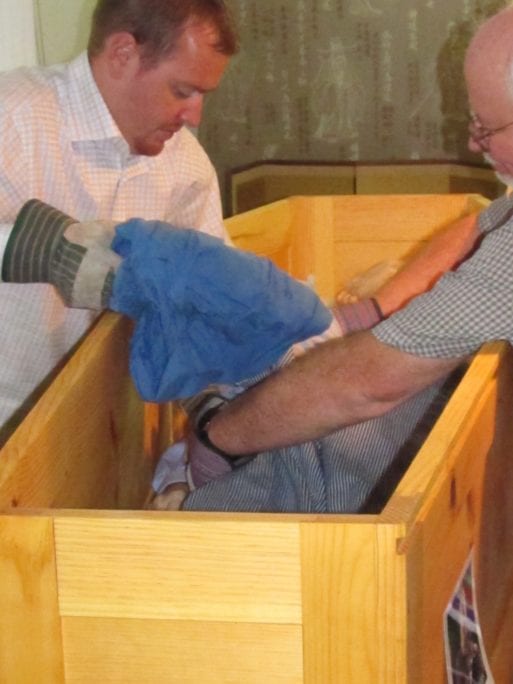
Bates and a family member prepare his father’s body for viewing and transport.
What was it like transporting your dad’s body?
He died at home, and we cleaned him up and put on a pair of adult diapers. And then we dressed him, put a shirt on him: pinstriped overalls, that’s what he wanted to wear. We lifted him up off the bed with the slip sheet and put him in the pine box, which had a light mattress in it, and then took him up to the front room. We got the dry ice, wrapped it up in the towel, and put that under his back. So no body bag — we just didn’t open the wooden box for a couple of days. We had a little service there at the house and then headed up to Tulia, Texas.
We hauled him in a Chevrolet Tahoe in late September. In Texas it’s still 95 degrees during the day, so when we drove cross-country, we had the air conditioner running. We stopped to eat — at cafes, getting pies and things like that — and we turned the engine off for an hour or so. No air conditioning. We also stopped at places where as kids, he would pull over and tell us stories — you know, “Here’s where the Comanches used to come across” and things like that. So that was part of the fun.
Then we got the hotel in Amarillo and were like, “Oh no, what do we do?” We had him in the pine box, with rope handles. We didn’t want to take him inside, because that would probably be bad for the hotel’s business. So we just left him out in the Tahoe and replenished the dry ice before we went to sleep. We also put a big old comforter over the pine box to hide it, and told the employees what was going on. In the morning, we crawled in there and popped the lid: “Eh, he’s cool.”
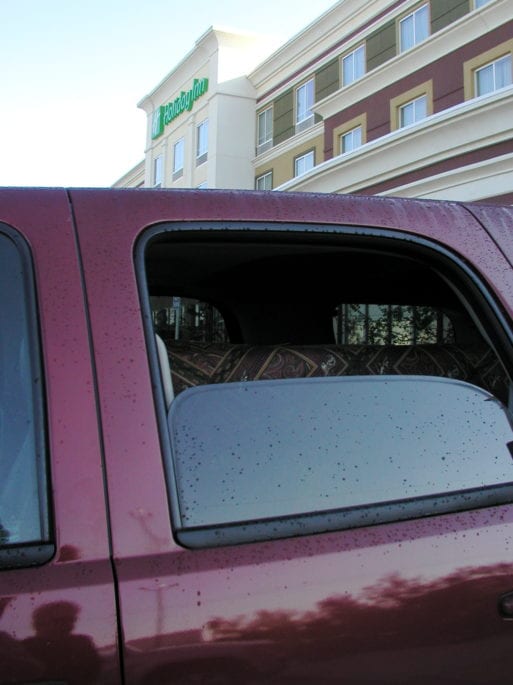
View through the window into the Chevrolet Tahoe, where Bates’ father was resting.
I guess the diaper would help with fluids. Is there anything else people need to worry about in terms of bodily fluids?
You’ve got to get the eyes closed. And I had a problem with keeping his jaw closed. I tried the standard old cowboy bandana, but his jaw just kept coming open. So I got some heavy-duty Webb straps for backpacking and rock climbing, and just cinched that over the top of his head and down around his jaw. That kept it closed pretty good.
I coached a guy about two months ago, he picked his father up at the nursing home to run him down to Houston and bury him there. There was heavy COVID at the nursing home at the time, but they just took the same precautions as everybody else — masks, gloves, all that. It’s a four- to five-hour drive, and they were about halfway when he called and said that the body was stinking bad. His dad was in a wooden casket, and he had the dry ice running, so it didn’t sound right. I had him pull over at a Buc-ee’s — it’s a Texas gas station chain. And I said go in there and buy all their air fresheners, like 20 or 30 of them, and all the free napkins you can get, and then go out there and open the box and see what’s going on. So he did that. And what had happened was his dad had three or four holes from where he’d had medical devices inserted into his body, and the nursing home had plugged all but one of them, so it was oozing out. And he got the Buc-ee’s logo napkins, and stuffed them there, and he got some duct tape and taped the hole closed. And then pulled his dad’s shirt back down, and spread those air fresheners all over.
Are there any special props that you would suggest people bring with them?
The thing that I’d recommend is that people have is a body bag. So if something goes wrong — you can’t get any more dry ice, or you’ve misjudged conditions — you can put them in there, zip that thing up and keep on going. You can buy military-grade body bags online — I think mine cost around 60 bucks. Worst-case scenario, you could wrap the body in a whole bunch of plastic, and use lots of duct tape.
What’s the longest time that someone should spend transporting a body? Does it matter as long as it’s cold, or is there a limit?
It really doesn’t matter, if you keep it cold. The state law in Texas, and it’s probably pretty standard, is that you’re supposed to dispose of the body within 14 days. What I tell people is, “Okay, 14 days is too long — you’re having a problem letting go.” But there’s nobody checking.
Are there any states that are especially strict around body transport?
There are seven or eight states out there that require a funeral director to be involved. The National Home Funeral Alliance has them listed on its website, along with other state regulations.
What was the experience with your father like for you emotionally?
The first five minutes were very difficult. I said goodnight to him at midnight, and went to sleep. And at 1:05, he was dead. It was expected, he was dying. But the main thing in that first five minutes was, “Okay, it’s time for my brother and I to do what we said we were going to do.” But once it got rolling — I really liked it, everybody liked it. The three grandkids, who were preschool, early school age, were the greatest. And so that helped mediate the starkness of it. “Fun” is not quite the word to use, but it became interesting and just really good.
When we all gathered at the hotel in Amarillo to go down to Tulia, there was a group of people that could tell something was different. They said, “Wait, what are y’all doing?” And we told them, and this older fella asked me if he could play Taps — he wanted to honor my dad’s service in World War II. He went to the trunk of his car, and he got out his bugle. We all gathered around the Tahoe. People coming in and out of the hotel could tell something was up, and everyone stopped. And they took their cowboy hats off and straightened their hair. He played, and it echoed off the side of that hotel’s four or five stories down to the asphalt parking lot. And it was just as haunting and beautiful and commemorative as anything you could ever plan on national TV.
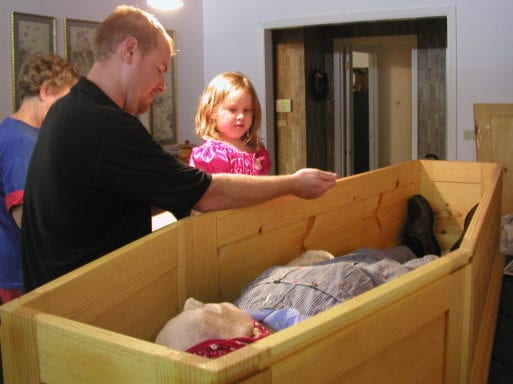
Bates’ granddaughter, along with other family members, view his father’s body.
The whole experience was just something else. My brother wrote a book about it called “The Final Road Trip: Dust to Dust”; it’s on Amazon. What the experience has taught me is that we’ve allowed the funeral industry to take away our spiritual, physical and mental needs to grieve in death. To where all we’re left with is to give them a credit card, and then eat potato salad and donuts and pizza until it’s time to go to the viewing. And then the next day we have a carbo-loaded breakfast, and then we go to the funeral and after that, we go eat steak and potatoes. And all of that eating and all that sitting around is just bad for us. It’s so much more natural and so much better for us to do something. Like plug your daddy’s leaking body with Buc-ee’s napkins and duct tape. It’s been six years since Dad died, and I when I reminisce about what happened, I just grin bigger and feel better all the time. There’s so much more to remember.
Did you ever see the movie “Little Miss Sunshine?” It’s a story about a kind of misfit family, but in the end, they’re on this crazy road trip and the grandfather dies and they end up shuffling him around in a van for a while. And there were a lot of mishaps, so your stories remind me of that.
That’s what you get. You’ve got two brothers driving down across the red canyons of west Texas, and they turn back and go, “Dad, do I still owe you any money or anything?” Just chatting to the dead body in the back. It has a lot of therapeutic opportunities. It’s just a great experience.
Another thing is that when we were just about ready to lower his box down into the grave, my granddaughter, who was five at the time, just walked over to her mother — my daughter — and got her phone and scrolled to a song. She had planned all this on her own. And she went over to the grave, leaned down and sang the song karaoke-style to my dad. There were 20 or 30 adults watching, and we were just bawling. That wouldn’t have happened had it been the creepy black Cadillac people in charge.
If you were going to give one important piece of advice to someone who’s looking to transport a loved one’s body, what would it be?
Just sit down and think about what it it’ll mean to you, and the story you’ll have after you do it. The logistics and the details will take care of themselves.

 DIY Body Transport by Vehicle: What You Can (and Can’t) Do
DIY Body Transport by Vehicle: What You Can (and Can’t) Do


 “Help Me, Helen”
“Help Me, Helen”
 Recovering Cremation Remains After the Los Angeles Fires
Recovering Cremation Remains After the Los Angeles Fires
 “As Tears Go By” by Marianne Faithfull
“As Tears Go By” by Marianne Faithfull














